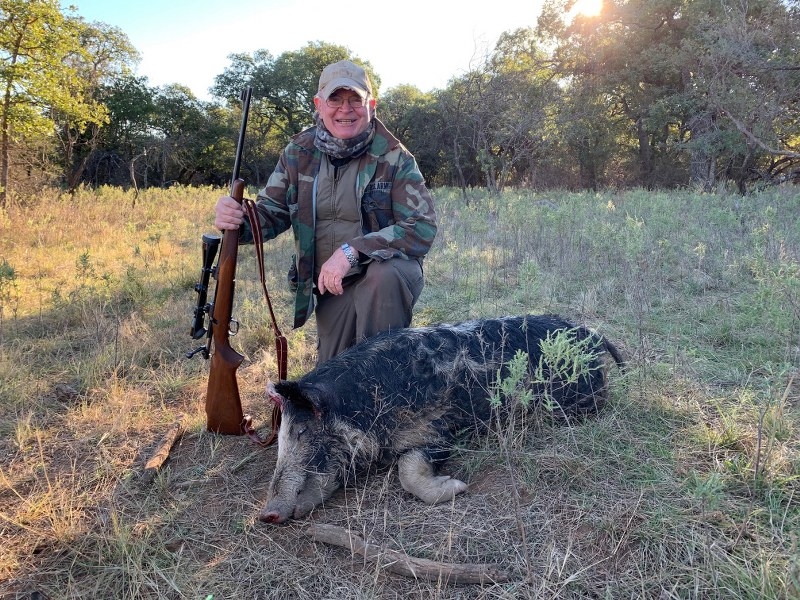
11/20/2021
Lone Star Hog Hunting at the Hatton Ranch: Taking Aim at Sus Scrofa
By: Keith R. Schmidt
Sitting quietly at a Hatton Ranch blind with good view through Central Texas scrub brush and woodland I’m quiet and looking with my guide for a White Tail Buck. One moment nothing: the next brush parting and eyes peering. Bring the rifle up to shoulder level, aim and begin trigger press. Don’t take long; only time enough to whisper: “Sus Scrofa.” And, my Winchester and I make this day lasting. But, he deserved it for all the trouble caused over so many years.
Sus Scrofa, the species descended from Eurasian wild boar goes by many aliases: wild swine, hog or simply pig ranks as the Number One Wildlife Problem placing him tops on Lone Star State Most Wanted Posters. And, while the Texas pig has no competition on his bad boy ranking most also agree that he also may be high on state hunting opportunities. A bitter pill to swallow for a state boasting well managed herds of White Tail Deer and exotic species at ranches like the Hatton.
“If you kill a wild pig at the Hatton Ranch, you’re our best friend,” said Pete Campbell, Hatton Ranch Manager, who is actively growing the ranch’s deer herd while working with its hunter to decrease the number of wild hogs. “There is no charge if you kill a wild hog at the Hatton Ranch and you can kill as many as you want. However, sometimes the hogs are there and sometimes they are not. So, it is just an added benefit to our guided deer hunts.”
A United States Department of Agriculture survey conservatively estimated annual damage to agriculture in Texas alone at more than $150 million. Field biologists estimate a state pig population well in excess of 2.6 million. Most other wildlife species don’t associate with wild hogs and for good reason. A hog readily consumes anything smaller or slower. White tail deer usually leave an area when hogs enter.
Considered a pest by Texas State Game Laws, ranch owners prefer hogs removed “with extreme prejudice.”
Hog History
The Texas hog problem was a long time coming. But, at least we have a person to blame: Hernando De Soto. This leader of the first Spanish/European expedition into Florida and the southeast in 1542 brought European pigs with him. De Soto died in what was to become the United States and expedition survivors eventually left; the hogs stayed.
In Texas, hog populations grew but in the 1980s populations exploded reaching what biologist call an exponential growth rate…a growth curve that gradually rise to a point of rapid takeoff that keeps pointing up.
Boarish Behavior
Pig social structure complements its intelligence. Bonding together in groups called “sounders.” An older sow leads the group of younger pigs containing a mix of several generations including males and all learn together from the leader. They soon understand where threats come from and the best places for food and shelter. Sounders often move in a specific area and can become territorial, readily change travel routes and become nocturnal with increased threat. Wild boars weigh up to 200 pounds with some extraordinary ones growing much larger. One hog recently downed at the Hatton Ranch by a female hunter’s .243 rifle weighed 419 pounds. Their jaws powerful enough to snap bone and given time can consume an entire animal carcass. A large hog can wind sprint up to 30 mph and jump a three-foot fence.
In special situations such as a sow defending piglets or when wounded, the hog will stand and fight. The skeletal structure of the neck does not allow it to easily bite upwards, but its tusks grow several inches long and its swinging head brings these formidable weapons into play uncomfortably level with a human’s groin and femoral artery. A reason a hunter should never step over a log; prefer not to be surprised by what may lie on the other side.
Choice of Weapons
Many hunters favor a special rifle for hogs often believing a need for larger, heavier caliber. However, a typical deer rifle works just fine. And, most hunters, like me, take hogs at the Hatton Ranch while deer hunting.
“While a pest, the wild hog deserves respect for his intelligence, adaptability and tremendous will to survive,” said Rich Clonts, Hatton Ranch owner. “Shot placement is everything and I tell our hunters to shoot the head or wait for that good broadside shoulder/lung shot.”
On our 2021 trip to the Hatton Ranch, my hunting partner shot three hogs and I shot five while we were out deer hunting. So, on a Hatton Ranch deer hunt, keep you rifle ready for Sus Scrofa, or, a coyote.
#
Keith R. Schmidt, long-time patron of the Hatton Ranch, is a writer and hunter living in the Houston area. Story copyright retained by author.
